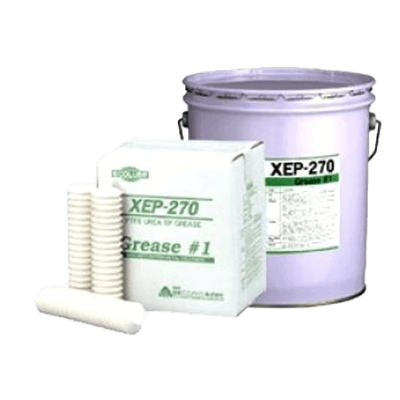What Is Urea Grease?

Urea grease is a grease that contains two or more urea bonds, which are difficult to decompose, and a thickening agent that ensures scientific stability.
The thickening agent is mixed with the liquid to make it semi-solid. Grease is generally used for machines that rotate at relatively low speeds, bearings that are subject to high loads, and sliding surfaces where metals slide against each other to reduce friction and the burden on equipment.
It is classified into various types depending on the thickening agent and base oil used, and the characteristics of the thickening agent in particular almost determine the characteristics of the grease. The characteristics of urea grease, which reflect the properties of urea, are higher heat resistance and water resistance than other greases.
In addition, urea grease has a unique consistency. Therefore, it can protect machinery for a longer period compared to other greases using thickening agents, which have the same hardness.
Uses of Urea Greases
Urea grease has excellent heat and water resistance. For this reason, it is often used in bearings and sliding parts of equipment that are driven under high temperature conditions.
For example, in metal rolling mills, machines must be operated under high loads and high temperatures while spraying cooling water. Under these special conditions, urea grease is suitable because of its excellent heat and water resistance.
Urea grease is also used in general household products. For example, it is used inside reels attached to fishing rods. By using urea grease with high water resistance, it is possible to protect the internal parts from seawater. The unique consistency of urea grease protects the precision gears inside the reel.
Principle of Urea Greases
Urea, which is used as a thickening agent in urea grease, is scientifically stable and has two or more urea bonds that are not easily decomposed. Ureas are further classified according to the number of urea groups: 2 is diurea, 3 is triurea, and 4 is tetraurea. Of these, diurea has superior performance as a grease. For this reason, diurea is widely used in urea-based greases.
Characteristics of Urea Grease
1. Chemical Characteristics of Urea Grease
Diureas are further subdivided according to the structure of the two ends of the thickener molecule. The classifications are aromatic diurea, aliphatic diurea, and alicyclic diurea. Among these, aromatic diurea has the highest grease performance, with excellent water resistance and shear stability. Other aliphatic diurea greases are fluid and soften in shear when shear force is applied.
When the flow stops and the shear elasticity is lost, the grease returns to its original hardness. It is suitable for use in centralized lubrication (a method in which grease is supplied to multiple locations by a single grease pump). Another advantage is that softening during shear reduces torque and noise when used in bearings.
In addition to the characteristics of the structure at the molecular level, the performance of the base oil (base oil) also has an effect on the grease. There are many types of metal soap-based greases, such as calcium soap, lithium soap, molybdenum disulfide, and lithium complex. On the other hand, non-soap-based greases exist, such as urea, of which urea grease is a typical example.
2. Physical Characteristics of Urea Grease
In general, the hardness of grease varies depending on the amount and type of thickener blended, and is indicated by “viscosity”. The “mixing consistency” value is generally used as the “degree of hardness”. Grease hardness is classified as No. 000, No. 00, No. 0, No. 1, No. 2, No. 3, No. 4, No. 5, and No. 6.
Grease with a degree of admixture modulus in the range of 445 to 475 is soft grease in a semi-fluid state and falls under No. 000. Grease with a miscible consistency ranging from 85 to 115 is labeled No. 6 and is very hard grease. Many urea grease products have a degree of mixing consistency of about No. 2 and are classified as normal hardness grease. Although the hardness is normal, the use of urea-based thickening agent makes this grease not only rustproof, lubricating, and wear-resistant but also highly heat- and water-resistant and long-lasting.
Other Information About Urea Grease
1. Types of Grease Thickeners
Tightener makes the base oil, which constitutes the grease semi-solid. By mixing the base oil with the thickener, the thickener is incorporated into the base oil and becomes semi-solid.
There are two major types of thickeners: metallic soap type and non-soap type. There are many types of metallic soap-based greases, such as calcium soap, lithium soap, aluminum complex, and lithium complex. On the other hand, non-soap-based greases include bentonite, PTFE, and urea, with urea grease being a typical product.
2. Disadvantages of Urea Grease and Measures to Deal With Them
Urea grease has many advantages over lithium-based grease, but it also has disadvantages. Some types of urea grease harden when used in high-temperature environments. This phenomenon occurs because the thickener molecules polymerize under high temperature.
Therefore, regular use near the heat resistant temperature may cause performance degradation due to hardening, so care should be taken. Before using this grease, please check the grease brand name thoroughly in the manufacturer’s catalog before applying it to the machine. There are also urea greases that soften and harden to a greater degree when sheared.
There is no problem if the selection or machine design is intentionally made to take advantage of these characteristics, but since unintended changes may cause malfunctions in the machine used, sufficient confirmation is required prior to use.